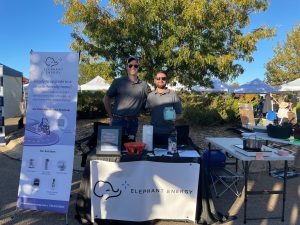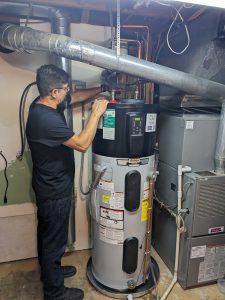If you’re considering a heat pump, the 2024 Federal Heat Pump Tax Credit can make it more affordable. This credit is part of the 25C Energy Efficient Home Improvement Credit, expanded under the Inflation Reduction Act. Homeowners can claim 30% of the cost, up to $2,000 per year, on qualifying heat pumps, heat pump water heaters, and related electrical upgrades.
This guide covers everything you need to know about how the federal heat pump tax credit works, who qualifies, and how to claim it.
What Is the Federal Tax Credit for Installing a Heat Pump?
The Federal Heat Pump Tax Credit is part of the 25C Energy Efficient Home Improvement Credit, expanded under the Inflation Reduction Act. It helps make energy-efficient upgrades more affordable by covering 30% of the total cost, up to $2,000 per year, for qualifying heat pumps and heat pump water heaters.
How It Works
This is a non-refundable tax credit, which means it directly reduces the amount of federal income tax you owe but won’t result in a refund. If the credit amount is more than what you owe, you can apply the excess credit to future tax years. This lets you maximize the benefit even if your tax liability is lower than the credit amount.
What’s Covered Under the 2024 Federal Heat Pump Tax Credit?
The 2024 Federal Heat Pump Tax Credit helps offset the cost of energy-efficient upgrades by covering a portion of your expenses. You can claim:
- 30% of the total cost, up to $2,000 per year for air-source heat pumps and heat pump water heaters
- $600 for electrical panel upgrades installed with a heat pump
- $1,200 per year for other qualifying energy-efficient improvements, such as insulation and air sealing
| For example, if you spend $7,000 on a qualifying heat pump installation, you can claim 30% of that cost, or $2,000, the annual cap. If you owe $3,000 in federal taxes, your tax bill would be reduced to $1,000 after applying the credit. |
Heat Pump Federal Tax Credit Requirements
To be eligible for the 2024 Federal Heat Pump Tax Credit, you must meet the following requirements:
1. Property Requirements
- The heat pump must be installed in an existing home and your primary residence in the U.S.
- New construction and rental properties do not qualify.
- Eligible properties include:
- Single-family homes
- Condominiums
- Mobile homes and manufactured homes
- Houseboats
- Cooperative apartments
2. Efficiency Requirements
The heat pump must meet the highest efficiency standards set by the Consortium for Energy Efficiency (CEE), including:
- A minimum SEER2 rating of 16 or higher
- Compliance with the CEE’s highest efficiency tier for air-source heat pumps or heat pump water heaters
3. Business Use of Home
If you use part of your home for business, you can still claim the credit, but it will be prorated based on non-business use:
- Up to 20% business use: You can claim the full credit
- More than 20% business use: The credit is proportional to your non-business use
4. Timing and Installation Requirements
- The heat pump must be installed and operational by December 31, 2024
- You must claim the credit in the same tax year the installation is completed
| Ready to Upgrade to a Heat Pump?Find out how energy-efficient heating and cooling can lower your energy bills. Learn more about Elephant Energy’s Heat Pump Solutions and see which high-efficiency system is right for your home. |
How to Get Federal Tax Credit for Heat Pumps: Claim and Filing
Here’s how to get the federal tax credit for heat pump installations:
Step-by-Step Filing Guide:
- Collect Your Documentation:
- Save your invoices and receipts showing the total cost of the heat pump installation.
- Get a manufacturer certification statement to prove your system meets the required efficiency standards.
- Fill Out IRS Form 5695:
- Fill Out Personal Information: Enter your Name, Social Security Number, and Main Home’s Address at the top of the form.
- PART I: Residential Clean Energy Credit: This section is for solar, wind energy, geothermal heat pumps, or battery storage. Skip this if you’re only claiming the heat pump credit.
- PART II: Energy Efficient Home Improvement Credit: This is where you’ll claim the heat pump tax credit, as well as credits for weatherization, electrical panel upgrades, and home energy audits.
- Continue filling out lines 17 through 32 in Part II.
- Section A: Qualified Energy Efficiency Improvements
- In Line 18, enter the total invoice amount for insulation and air sealing.
- Section B: Residential Energy Property Expenditures
- In Line 25ab, enter the total invoice amount for electrical panel upgrades.
- In Line 29abc, enter the total invoice amount for heat pumps and/or heat pump water heaters.
- Section A: Qualified Energy Efficiency Improvements
- Continue filling out lines 17 through 32 in Part II.
- Integration with Form 1040:
- Add the relevant tax credit details from Form 5695 to your standard Form 1040 when filing your federal taxes. This ensures the credit is accurately applied to your tax bill.
- Submission Reminder:
- Attach Form 5695 to your federal tax return (Form 1040) when filing. This is required to claim the credit.
- Keep Your Records:
- Hold onto all documentation, including invoices and certification statements, for at least three years in case of an IRS audit.
Additional Energy Efficiency Tax Credits
In addition to the heat pump tax credit, the 25C Energy Efficient Home Improvement Credit covers other energy efficiency upgrades. Pairing these improvements with a heat pump installation helps you maximize your savings while enhancing your home’s overall energy efficiency.
Home Energy Audits
You can also get a tax credit of up to $150 for a home energy audit conducted on your primary residence. To qualify, the audit must:
- Include a written report and inspection that identifies the most significant and cost-effective energy efficiency improvements, along with estimates of potential energy and cost savings.
- Be conducted by a certified home energy auditor to ensure accuracy and credibility.
Pairing a home energy audit with a heat pump installation helps you identify additional energy-saving opportunities, maximizing your overall savings.
Energy Efficiency Upgrades
The 2024 Federal Heat Pump Tax Credit is part of the 25C Energy Efficient Home Improvement Credit, which also covers other energy efficiency upgrades. You can claim 30% of the project cost, up to $1,200 per year, for qualifying improvements, including:
- Attic Insulation
- Basement or Crawlspace Insulation
Pairing these upgrades with a heat pump installation helps you maximize your savings while improving your home’s overall energy efficiency.
Need More Details on Filing?
For more detailed instructions, check out:
| Ready to Upgrade Your Home’s Comfort and Efficiency? Start your journey to lower energy bills and a more comfortable home. Get an Instant Quote for Heat Pump Installation from Elephant Energy and see how much you could save with a high-efficiency system. |
Additional Resources: Rebates and Tax Credits Directory
Looking to maximize your savings? The following will take you to relevant Elephant Energy resources that explain how to make the most of available financial incentives, including rebates and tax credits:
- Inflation Reduction Act Tax Credits for Heat Pumps: Learn how the IRA supports heat pump installations with additional tax incentives.
- Making the Most of Inflation Reduction Act Incentives: Discover how to combine IRA incentives with other rebates for maximum savings.
- Climate-Friendly Home Incentives: Explore incentives for electrifying your home, from heat pumps to EV chargers.
- Colorado State Heat Pump Tax Credit: Find out how Colorado residents can save even more with state-specific tax credits.
- Mass Save® Rebates: See how homeowners in Massachusetts can benefit from exclusive heat pump rebates through the Mass Save® program.
Why Choose Elephant Energy?
Upgrading to a heat pump is a smart way to lower your energy bills, reduce your carbon footprint, and take advantage of the 2024 Federal Heat Pump Tax Credit. With the right system, you can get money back at tax time while making your home more comfortable and energy-efficient.
Elephant Energy makes the process simple and stress-free. Our team handles every detail, from helping you choose the right heat pump to guiding you through every rebate and tax credit available.
Ready to maximize your savings? Get an instant estimate to upgrade your home and invest in a more sustainable future.
Frequently Asked Questions
Can I combine this tax credit with other incentives?
Yes, you can combine the federal tax credit with state rebates or utility incentives. The federal credit is calculated based on your out-of-pocket costs after other rebates are applied, letting you maximize your savings.
Can I claim this credit if I received a state rebate?
Yes, but the federal tax credit will be calculated on your costs after the state rebate is applied. This means you’ll get credit for what you actually spent out of pocket.
Do rental properties qualify if I live there part-time?
No, rental properties do not qualify, even if you live there part-time. To get this credit, the heat pump must be installed in your primary residence.
What if I don’t owe enough in taxes to use the full credit this year?
This is a non-refundable credit, so it can only reduce your tax bill to zero, not below. However, you can use your unused credit for future tax years to make the most of the credit.
Disclaimer:
This guide is for informational purposes only and should not be considered tax advice. Individual tax situations can vary, so it’s recommended to consult a licensed tax professional for personalized guidance. Elephant Energy does not assume liability for your specific tax circumstances.

 To understand why “making it last” is so critical for efficiency, we first need to do a teeny science lesson on something called
To understand why “making it last” is so critical for efficiency, we first need to do a teeny science lesson on something called